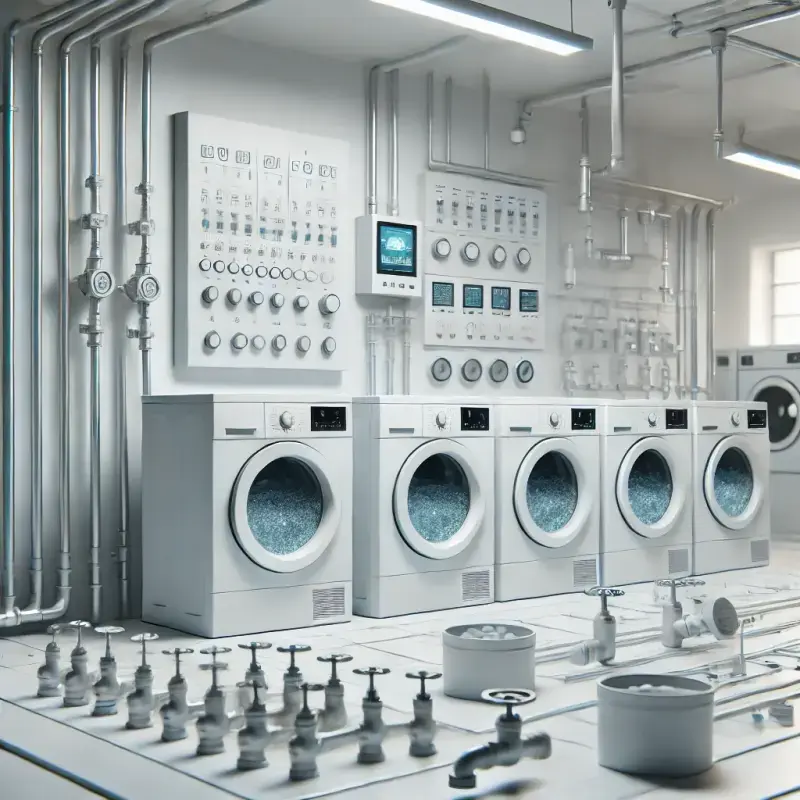Smart Technologies for Reducing Water Consumption in Laundries
Commercial laundries consume a significant amount of water daily, and this heavy demand presents both economic and environmental challenges. However, advancements in smart technologies have introduced innovative solutions to reduce water consumption, helping laundries optimize their operations while minimizing their environmental impact. From water recycling systems to precise monitoring and control devices, these solutions are transforming how laundries manage resources.
In this article, we will explore the key smart technologies used in modern laundries to save water, discussing how they work and the benefits they provide.

Water Recycling Systems
One of the most impactful innovations in reducing water use in laundries is the implementation of water recycling systems. These systems capture and treat wastewater from laundry processes, making it reusable for subsequent cycles.
Water recycling in laundries typically involves several stages:
- Filtration: Wastewater passes through filters that remove large particles like lint, hair, and fabric debris.
- Sedimentation: In this step, smaller particles settle at the bottom of the treatment tank.
- Disinfection: The water is treated with UV light or chemicals to eliminate bacteria and other harmful microorganisms.
- Reuse: Cleaned water is then stored and pumped back into the washing machines for future use.
By using recycled water, laundries can significantly reduce their dependence on fresh water, leading to lower utility costs and less strain on local water supplies.
Advanced Washing Machines with Water-Saving Features
Modern washing machines designed for commercial use are now equipped with a variety of smart technologies aimed at conserving water. These machines use sensors and sophisticated algorithms to optimize the water required for each load based on its size, fabric type, and soil level. Some of the water-saving features include:
- Load Sensing Technology: Automatically adjusts the water level to match the load size, preventing the use of excessive water for small loads.
- Eco-mode: A setting that minimizes water use by extending the washing cycle and using lower water temperatures without compromising cleanliness.
- Smart Valves: These precisely control the amount of water entering the washing machine, ensuring that no excess water is used.
These innovations enable laundries to perform efficiently while drastically reducing unnecessary water consumption.
Real-Time Monitoring and Control Systems
Smart monitoring systems allow laundries to track water usage in real-time, providing insights that help manage consumption more effectively. These systems gather data on each cycle, load, and water usage pattern, offering detailed reports that laundry operators can use to make informed decisions.
- Water Flow Sensors: Installed in various parts of the laundry system, these sensors measure water flow and help detect any leaks or inefficiencies that could be wasting water.
- Data Analytics Platforms: Advanced data platforms collect and analyze water usage data, allowing operators to identify patterns and adjust machine settings accordingly to minimize waste.
- Automated Alerts: Many systems send automated alerts when water consumption exceeds preset limits or if irregularities such as leaks occur.
With real-time data and control, laundries can continuously optimize their processes, leading to substantial water savings over time.
Low-Water Use Detergents
While technology plays a major role, the type of detergent used also influences water consumption in laundries. Many commercial detergents are now formulated to work effectively in low-water conditions. These low-water use detergents produce fewer suds, making it easier for washing machines to rinse clothes with less water. Combined with smart washing machines, these detergents allow for shorter cycles with reduced water requirements.
Smart Leak Detection Systems
Even minor leaks in a laundry facility can lead to significant water waste over time. Smart leak detection systems can identify even the smallest leaks and alert operators immediately, preventing unnecessary water loss. These systems work by constantly monitoring water pressure and flow through the pipes, automatically shutting off water supply to affected areas if a leak is detected.
- Pressure Sensors: These detect fluctuations in water pressure, which can signal leaks or equipment malfunctions.
- Automated Shutdowns: Upon detecting a leak, the system can automatically shut off water to avoid further waste until repairs are made.
Water-Efficient Dryers
Though dryers don’t use water directly, their efficiency can indirectly influence water usage in laundries. Smart dryers with moisture sensors can detect when clothes are dry and shut off automatically. This prevents overdrying, which can cause fabrics to wear out faster, leading to more frequent washing and increased water consumption.
Conclusion
Smart technologies are revolutionizing the way commercial laundries operate, helping them reduce water consumption and operate more sustainably. From water recycling systems to advanced washing machines and real-time monitoring, these innovations offer a comprehensive approach to water efficiency. By adopting these technologies, laundries can not only cut costs but also contribute to global water conservation efforts.
As more laundries integrate smart solutions, the future of water-saving in this industry looks promising, benefiting both businesses and the environment.
Articole
Abonați-vă pentru a primi primele cele mai noi și originale rețete direct în căsuța de e-mail!